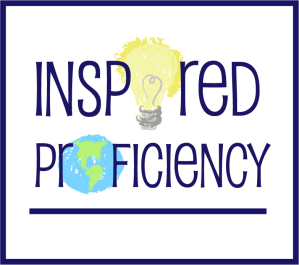Welcome to Inspired Proficiency and thank you for joining us for season 4, episode 8. As always, please tweet any takeaways and inspirations to #inspiredproficiency. Don’t forget that Ashley and her podcasts are also on Facebook in the group “Inspired Proficiency Teacher Collaboration” with lots of great ideas for the classroom.
Download the episode here or listen and subscribe on Apple Podcasts here or find it wherever you listen to podcasts!


Our presenting sponsor Wayside Publishing invites you to stop at their ACTFL Conference Booth (811) to visit with Ashley and play Proficiency Pyramid.
Ashley will be presenting two sessions in DC, here are the details!
On Friday 11/22/19 at 2:30 PM in room 152A Ashley will be presenting about “ Work-Life Balance Through Effective Minimalism in Assessment and Planning.”
On Saturday 11/23/19 at 4:30pm also in room 152A Ashley will be presenting on “Passion, Play, and Proficiency.”
Stop by the ACTFL Booth, attend Ashley’s sessions, or tweet with her @ProfeAshley to meet her at the conference. She loves to connect with fans hear ideas for future podcast episodes! Keep in touch and enjoy conference season!
Today’s Panel on Culture in the Communicative Classroom:
Panelist #1: Kristen Keefe teaches Spanish in New Jersey and has been teaching many levels of high school Spanish for 19 years. She shared some game ideas on a season 1 episode 5 of the podcast. 
- Leveled Readers that have a cultural connection
- Fiction and nonfiction
- Can talk about holidays or events in culture
- Everyone is using the cultural content as a class in a meaningful way
- These provide a jumping off point to pull in relevant related authentic resources
- Provides entrypoint into cultural things that might not normally be a topic but is interesting and relevant to students
- Offers pathways to learn about different countries and topics not widely discussed
- Students will buy in and sometimes research into things on their own with motivation
- A story provides a vehicle to connect with the stories and still acquire content
- Everyone loves a good story!
- Pull in news articles and songs….. Anything relevant to what you’re reading to connect to the topic
- Can be relevant to bring in other topics and cross curricular content links
- Stories can have great morality pieces and deep discussions for students to have about life and the world
- Stories are also written with good grammar so students can pick up grammar topics by absorbing them within the story (realistic use of language to teach it)
- Read the books first
- Invest in a book before you buy them for the class to make sure that they will enjoy reading it, you can relate content to it, it’s readable, it’s relatable, it’s appropriate
Panelist 2: Julia Koch has been teaching high school French for the last seven years in New Jersey. She has made many presentations on Intercultural Competence.
 Definition of Intercultural Competence
Definition of Intercultural Competence
- Deardorff says it is “the ability to develop targeted knowledge, skills, and attitudes, that lead to visible behavior and communication that are both effective and appropriate in intercultural interactions”
- Intercultural Development Continuum (IDC)
- Created for businesses to use to be appropriate in the business world
- More information on IDC and credit for image below
-
- Denial
- Present students with the differences in the cultures
- Expose them to the idea that people do things differently all over the world
- Any exposure will begin to help them get away from the denial stage
- Polarization
- Students judge the differences they’re presented with
- Can happen at the same times as the denial stage
- Have to practice non judgemental processing
- Start by focusing on the facts about what makes it different with objectivity and then start thinking about your personal opinions
- Minimization
- This is almost as far as we can take them with the amount of time we have with them in class (like the proficiency levels, depending upon your program you might not get your kids much passed intermediate high and that’s ok, you only have so much time)
- Students start to downplay the differences by understanding and accepting the differences by seeing we’re all the same but different at the time
- Acceptance
- We probably won’t get here in class time.
- Aware of the differences and deeply comprehend them
- Shift from monocultural to intercultural mindset
- Adaptation
- We probably won’t get here in class time.
- Capable of bridging across the differences and interact seamlessly with the target culture
- Probably happens if they travel, study abroad, or have the ability to interact with other cultures outside of school
- Denial
- TIPS!
- Help them move through these levels by showing them representations of their own culture through the lens of other cultures
- BuzzFeed France people from Mexico trying American snacks
- What do other people think of your culture? To get students to reflect on their own culture
- There are tons of social media pages to help find information about the topics you’re covering
- NEVER stop drawing attention to differences
- Students can fluctuate along the continuum so they may seem to be ok with some aspects of culture but can drop back down to denial at anytime
- Model, practice, reinforce non judgmental response to something
- Explain objectively BEFORE feelings are mentioned
- Give them space for their feelings to be shared
- Make sure they look through their own personal cultural lens to examine their feelings
- She prepares basic open ended questions to help students open their mind when talking about differences
- Help them move through these levels by showing them representations of their own culture through the lens of other cultures
- Julia believes that a huge chunk of language teachers believe this can’t be done in the target language in the novice levels and that is incorrect!
 Panelist 3: Stephanie Carbonneau has been on the podcast many times and is an avid fan! She teaches middle school French in Maine.
Panelist 3: Stephanie Carbonneau has been on the podcast many times and is an avid fan! She teaches middle school French in Maine.
- We are told to lead with culture!
- We need to know their culture in order to teach them about other cultures!
- Build relationships with the kids!
- Every town and community is different from within their state and outside of it.
- We need to make sure we don’t generalize and compare everyone together when they’re all unique.
- Student levels might be novice but…
- Paul Sandrock of ACTFL says they speak at a novice level but inside their head might not be
- What they’re learning needs to be relevant for their age
- Currencies and professions might not be important to their age level in middle school
- Apply these to your current themes and see what you can bring in with authentic materials
- Essential questions
- Reflective of the culture and the students’ lives
- What do the sports and activities and pastimes I do say about me, about others, and about a culture?
- Investigative approach to culture related to students
- Not important to just be told about these differences but to investigate and understand it deeply
- Which language?
- Target language or English?
- Should be in the TL and at their proficiency level
- Novices can identify information
- Intermediates can compare and contrast
- Advanced can tell you story with details and write long paragraphs
- Tasks at the Novice level
- Processing tasks because they don’t have the high level of language to share what they can see or know about the activity
- Pictures with questions
- Yes or no
- Are there desks?
- This or that
- Are the students young or old?
- Scaffold the task for their level
- Draw
- Match
- Highlight
- Find the evidence in the text
- Circle the drawing to highlight or articulate
- Provide more vocab for them
- Multiple choice (but show evidence)
- Venn diagrams
- See, think, wonder (investigate)
- Provide these sentence starters for the students to use
- What’s there in the example?
- What’s not there in the example?
- Don’t get caught up in the grammar, simplify it for the kids with simple language
- Guessing games
- Sentence starters
- Chat Mat with words they need to help them increase their proficiency level
- Surveys
- Ask each other about the information and completely involve them in the discussions of comparing and contrasting
- Use this info to compare with a school you’re connected with in another country (if you can find this connection)
- Because
- Extend what you’re trying to say with reasons and evidence
- I’m the same because…
- I’m different because…
- Processing tasks because they don’t have the high level of language to share what they can see or know about the activity
 Panelist 4: Melanie Reid Thomas has also been on the podcasts twice before. She currently teaches Spanish in New York and has experience in several levels including middle school and high school.
Panelist 4: Melanie Reid Thomas has also been on the podcasts twice before. She currently teaches Spanish in New York and has experience in several levels including middle school and high school.
- She used to just do a Cultural Friday and was not happy with that.
- Loved when ACTFL came out with a culture standard and included products, practices, and perspectives.
- Stephen Krashen says it needs to be “truly compelling” for students to learn and since culture is a compelling topic that should be covered in class.
- Ideas
- Find a hook
- Backwards design the topic you want to include
- Is there artwork? Music? Products to buy from the country? Commercials? Podcasts? Crafts?
- Slowly immerse them in the world of this culture
- Focus on the geography of where they’re going to learn about
- New units means new proficiency levels with high students will drop back down to novice to focus on new vocabulary and information they don’t know anything about
- Google street view
- Video of that place live from the internet
- Students:
- List what they see
- Check off what they see
- Music can support visuals or products or vocabulary or the culture
- Example of “Calma” Remix about slowing down and relaxing at the beach, learning some dance moves, look at the map
- Helps to lower affective filters so students can learn
- Example of “Robarte un Beso” song has nothing to do with a certain aspect of culture but the videos have tons of views of Colombia and the clothing and the kids
- Example of “Bicicleta” and more views of Colombia
- Example of curanderos and a Juanes song where he visits one of those in the middle of the night in the video to introduce health topics and doctors and curanderos in Spanish speaking countries
- Example of “Estoy mala” and staying within that health unit and hearing comprehensible language
- Kids don’t have to like this stuff but they need to tell you in the target language. They might like but WHY and they can tell you
- Art
- Colors
- Objects
- Dictate what to draw blindly from someone who can see the picture in the hallway
- Black and white versions where they just tell them the colors to color
- Gallery walk
- Leads up to theme
- Is the theme
- With questions or without
- Check marks looking for objects
- Authentic artwork reflecting the cultural aspect you’re studying
- Podcasts
- Crafts
- Buy products and bring them in to class
- SHIFT!
- Instead of fitting culture into the topic and the unit USE THE CULTURE as the driving force to deliver the language instruction through the vehicle of the culture
- Use the same topic at all language levels and just use different proficiency level tasks and activities for the students
- Immerse students in the celebration of other cultures
- Make time to offer students a chance to output what they’ve learned if they’re ready
- Ask if they have questions, comments, connections, opinions
- Time to remember this moment they are immersed in
- Allow it, don’t force it
Game Segment with Sarah Breckley:
Bread and Butter
- Need small pieces of paper, pen, tape
- Papers have one word written on it
- Taped to students back, they can’t see their own words
- Words are some sort of pair to make a match, or opposites
- They have to search for a partner but they don’t know what’s on their back
- They cannot pair other people or help them, just have conversations to help them figure out what their word is
- They think in their mind who their partner is but they DON’T say anything and help others think about theirs
- Return to seats and write down possible match
- Have conversations as a big group about who and why and great discussion of why correct or not and how words can relate to each other
- ANY CONNECTIONS are a winner because they argue their point about why
- Personalize the words with topics from stories or class or whatever you want it to be
- Monitor the English side conversations so students don’t ruin the game
Resources and links mentioned on the show:
- Felipe Alou Book from Fluency Matters
- Inspired Proficiency Season 1 Episode 5 with game ideas from Kristen Keefe
- Darla Deardorff and research on Intercultural Competence
- More information on Intercultural Development Continuum (IDC)
- BuzzFeed France
- Julia’s Presentation Slides “Is this real life? Intercultural Competence in the Language Classroom”
- Julia recommends Dorio Conlon Perugini for more Intercultural Competence information and on Twitter @DorieCP
- Stephanie Carbonneau’s previous Inspired Proficiency episodes
- Paul Sandrock on Twitter @psandrock
- Melanie Reid Thomas
- ACTFL World Readiness Standards Explanations
- Stephen Krashen “The Compelling Input Hypothesis”
- “El Ekeko” mentioned by Melanie Thomas. Also available from Fluency Matters
- “48 Horas” by Carrie Toth mentioned by Melanie Thomas. Also available from Fluency Matters.
- “Calma” song remix by Pedro Capó, Alicia Keys, y Farruko
- Biblioburro
- “Robarte Un Beso” song by Carlos Vives y Sebastián Yatra
- “Bicicleta” song by Carlos Vives and Shakira
- “La Plata” song by Juanes
- “Estoy Mala” song by Pinturilla
- Carrie Toth
- Martina Bex
- Arianne Dowd
- Kara Jacobs
- Michelle Walpole on Twitter @SrtaWalpole
Guests:
- Kristine Keefe on Twitter @kkeefe_hassan and her blog and she is also on the board of FLENJ and their 2019 Teacher of the Year! Congrats!
- Julia Koch on Twitter @jaybeekay518 and her blog
- Stephanie Carbonneau on Twitter @MmeCcarbonneau and her blog
- Melanie Reid Thomas on Twitter @senoraMThomas and her blog
- Sarah Breckley on Twitter @SarahBreckley
Season sponsorship brought to you by:
- Wayside Publishing #followtheowl Check out their Proficiency Talks!

Episode sponsors:
